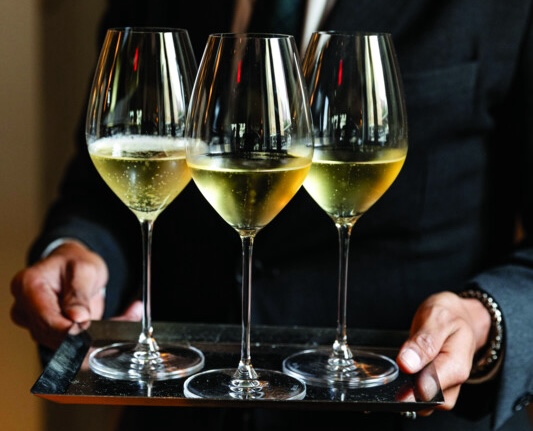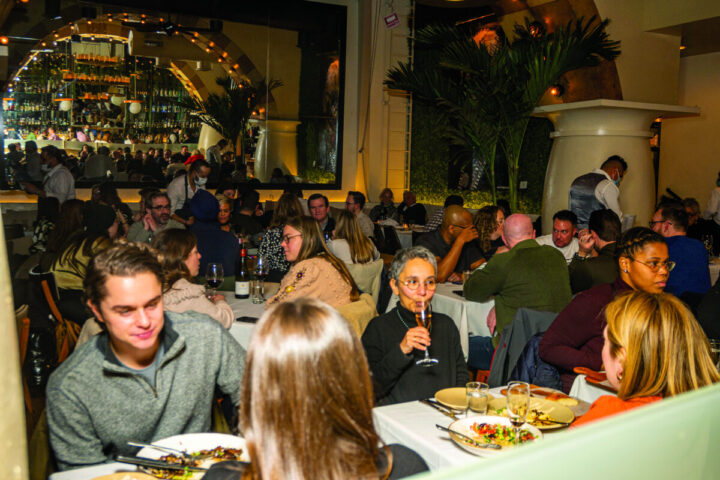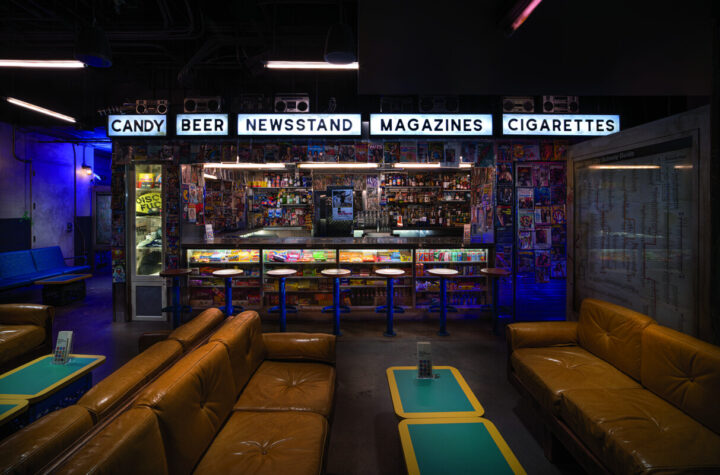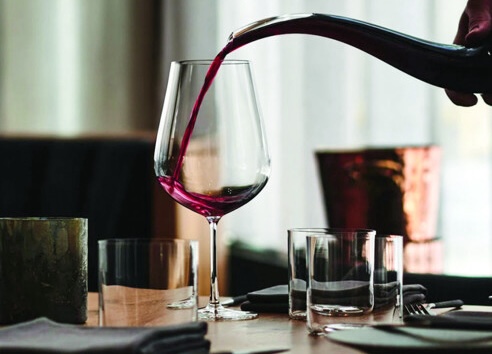
At CoCo Noir Wine Bar in Oakland, California, the approach is simple. In a world awash with thousands of wine options, CoCo Noir specializes in featuring wines by people of color, women, producers from the LGBT community, and family-owned wineries. “Featuring Black-owned labels has been a real hit for us,” says manager Shannon Holbrook. “A star selection is Sun Goddess by Mary J Blige.”
In fact, the “wines of the week” for the second week of May 2025 featured two Sun Goddess options—the Sun Goddess Mood Goddess Red Blend ($16 a glass; $10 during happy hour promotions) and Sun Goddess Brut Prosecco ($15;$10)—as well as Intercept Cabernet Sauvignon ($14;$10) from NFL star Charles Woodson and LVE Chardonnay ($17;$10) from singer John Legend. These were joined by four additional wines of the week. “We [feature] an average of eight wines in six-week rotations,” Holbrook says. “This keeps the customers engaged and excited for the next wine adventure we provide.”
Wine-by-the-glass programs run the gamut, of course, ranging from selections of familiar favorites to targeted wine types to esoteric labels. “The selection has to complement the cuisine, appeal to the clientele, and have a diversity in style from esoteric to wider appeal,” says Aviram Turgeman, beverage director and partner of New York City-based Chef Driven Hospitality, whose restaurants include Marseille, Nice Matin, Cafe D’Alsace, L’Express, Barbounia, Dagon, Acadia, Sempre Oggi, 5 Napkin Burger, and more.
“The strategy is to offer just enough but not too much, so we maintain focus, freshness, and properly trained staff,” Turgeman says. Lists typically include at least one Champagne, a Loire Valley Sauvignon Blanc, and a Côtes Du Rhône, as well as rosé from Provence all year round.
New York City’s The Noortwyck takes a similar approach, with co-owner and sommelier Cedric Nicaise selecting a range of white, red, rosé, sparkling, skin contact, and sweet wines, usually numbering 16 selections in total. “We don’t have too many rules, most are based on pricing,” Nicaise says. “We want to have a healthy mix of price options ranging from the mid-teens to the mid-twenties. Within that price range we try to have a variety of style options: light wines, higher acid wines, and more neutral profiles. Basically, we try to make sure no matter your preference, there’s something on the list for you. We try to have some options that are more mainstream—think Pinot Noir or Chardonnay—but also include wines that are off the beaten path, such as Verdeca or Frappato.”

Familiarity And Fun
Luke Boland, corporate wine director for New York City-based Hospitality Department, wants by-the-glass selections at the company’s Point Seven, Coral, B&L Diner, and The Bronze Owl restaurants to feel recognizable and inviting. “Across all locations, we want to offer mostly familiarity with a little sprinkle of fun,” Boland says. “You will always see classics like Chardonnay, Sancerre, Pinot Noir, and Cabernet Sauvignon in almost all of the restaurants, but we have some fun pours in different places for those who want to explore.
“At Bronze Owl, we have a Tuscan orange wine, the 2022 Ficomontanino Tuscan Blend ($18 a glass), and the unique Kerner grape from Trentino-Alto Adige, with the 2022 Kofererhof Kerner Trentino-Alto Adige ($19),” Boland adds. “Point Seven currently has what we call a “dry-ish” Riesling, the 2023 Eva Fricke ‘Verde’ Riesling ($19) from the Rheingau region of Germany, and we often have a rotating South African or Portuguese white wine by the glass that fills in an “off the cuff” coastal vibe white that is a bit different. There are always staple grape varieties, but producers might change on availability and whimsy.”
Boland adds that most of company’s restaurants feature at least eight wines by the glass. “Pretty much every spot has four whites and four reds, with slight tweaks: Point Seven has a few more whites for example, and there’s also a robust Champagne by-the-glass program at Point Seven to offer a variety of luxury bubbles to go with our seafood and raw bar,” Boland says. “Champagne houses like Roederer, Dom Pérignon, Krug, Philipponnat, and Pol Roger are all currently poured at Point Seven, for example. We might also do something seasonal. Last holiday season we were pouring the stellar Arnaud Baillot Vosne Romanée—a wine that could easily sell for $70 a glass—for $35 a glass to offer some serious holiday value in a region that just keeps getting pricier.”
Fun is also a focus at Spiegelworld in Las Vegas, which encompasses Diner Ross, Glitterloft, 99 Prince, and Discoshow. Executive wine director Drea Boulanger says the goal is to offer a broad selection of wines at various price points to appeal to a range of tastes. “At Diner Ross, I feature about 18 options, including sparkling, white, red, rosé, and dessert wines,” says Boulanger. “This always includes a range from dry to sweet, providing flexibility for pairing with dishes across the menu.”
It’s at Glitterloft and 99 Prince where guests often gather before heading to the Discoshow nightclub, where the strategy diverges a bit. “I’ve taken a different approach with a selection of high-quality canned wines,” she says. “This includes sparkling wine from Oregon and Pinot Noir from Chile in 250-ml. cans, allowing guests the convenience of bringing their beverage into the show. There are fantastic wines being made in alternative packaging, and it’s great to be able to offer those as an option for our guests.”
Overall, Boulanger says, “we love a ‘wild card’ at Spiegelworld. Champagne is a must-have, no question. I also typically include a sweeter option like Riesling or Moscato, along with a few bold red wines, which are popular with our clientele. Currently, the wild card is a white blend from the Rhône Valley, and I rotate selections regularly to reflect shifting consumer preferences.”

Enhancing The Vibe
Of course, wine-by-the-glass offerings often reflect the cuisine or vibe a restaurant is seeking to convey. New York City’s Shmoné Wine Bar, for example, takes a global approach “I serve 16-20 wines by the glass on my wine list,” says wine director Yonatan Chaitchick. “This selection includes two sparkling wines, five to six white wines, a rosé, an orange, and five to six red wines. I also serve three to five more expensive wines using a Coravin system.
“I will always have Champagne, White Burgundy, red Burgundy, and Israeli wine on the list,” Chaitchick continues. “In addition to those, I select wines from lesser-known wine regions or unique grapes from classical regions. Right now, I’m serving an incredible Sauvignon Blanc from Alto Adige by a producer named Ignaz Neidrist ($21 a glass). This wine is my alternative to Sancerre, which many guests ask for.”
Some wine professionals are forced to work within fairly stringent parameters. At Yolan, the Italian restaurant located inside the Joseph Hotel in Nashville, Tennessee, senior food and beverage manager Stefan Milic says the by-the-glass program “is designed to reflect our refined Italian identity while remaining approachable for a broad range of guests.” With 12-15 selections at any given time, the program “is rooted in showcasing Italy’s regional diversity while honoring benchmark expressions from other world-class wine regions.”
The “must-haves” at Yolan include a deep, structured Cabernet Franc from Napa Valley, a mineral-driven Sancerre from the Loire Valley, and an Italian staple such as Chianti Classico or Nebbiolo. “Nice-to-haves” include a crowd-pleasing Pinot Grigio, as well as something a bit more esoteric. Milic says he seeks “a selection that sparks conversation, such as a smoky Nerello Mascalese from Sicily, the 2020 Metodo Classico Rosé ($20 a glass), or a white like Quintodecimo ‘Jaune d’Arles’ Greco di Tufo ($33), which draws on one of the oldest wine varietals linked to ancient Greek origins.”
At French restaurant l’abeille in New York City, beverage director Pamela Walton gravitates toward classic flavor profiles and well-known varietals and regions. “Our approach, because of the French and Japanese cuisine, tends to lean on classic French options,” she says. “The must-haves are a white Burgundy, a red Burgundy, and a high-end Champagne. Sancerre is also often called for, so if not Sancerre, we must have a Sauvignon Blanc from a neighboring Loire village.”
Entrants that break away from the classics typically don’t perform well. “We currently have a Trebbiano on the list, and while it is textured and certainly complementary to many items on our list, it is a sleeper in the end,” Walton says.
Wines by the glass are a relatively small portion of sales at La Bastide by Andrea Calstier, in North Salem, New York, according to chef-sommelier David Berube, accounting for about 10% of total wine sales. “If a [menu] includes five by-the-glass options, I will try to showcase one style chosen for education purpose, three styles that speak to the majority of our guests and pair with the menu, and a high-end option for those who want to treat themselves with a very fine glass of wine,” he says.

Educational Approach
Like Berube, many wine professionals use their by-the-glass lists to excite wine drinkers about labels or wine types they might not yet have been exposed to. “[The by the glass program] is such a great way for our service staff to make a connection and start conversations with guests,” says Kelly Sundberg, general manager of Sogno, an Italian restaurant near Boston. “Our flight option from our cellar selection is a great way for folks to try a few different wines that they would normally only ever see by the bottle—Sassicaia included.”
Aidan Cooper, wine director at New York City’s Vestry, agrees. “I am always seeking to educate, sometimes to a fault,” he says. “The time I spend in the cellar is grand but it’s the time spent with the staff and tableside speaking with guests that I truly value. This is an industry that will only be helped by educating those around us so we can all move forward together in hospitality.” His by-the-glass list seeks to highlight unique wines. “My aim is to focus on ‘conversational and impactful’ wines by the glass that allow for guests to really engage, and with a thorough wine cellar, I am able to rotate the selections fairly.”
Wine professionals must balance their approaches, however many say that too much focus on conveying information can make guests shut down. “Generally, I don’t think people coming to dinner are looking for an education,” says Nicaise of The Noortwyck. “Some guests want to have a new discovery or try something interesting, but a sommelier standing at a table lecturing the merits of St. Laurent is not my idea of service. Instead, we focus on building a by-the-glass list that includes a few interesting and unique options, while ensuring our staff is fully versed in the wines so that if someone asks, they have all the details.”
Others agree. “We are always happy to educate, and we are up-to-date on the stories, producers, and wine-making choices of our by-the-glass wines,” says Walton of l’abeille. “But our clientele is a little savvy and knows what they like, and so we are not gearing our wines-by-the-glass selections with the priority to introduce new varietals and regions to the guests.” She notes that the restaurant offers more creative options with its pairing program and its by-the-bottle list. “As well, we have additional sommelier selections every evening, where we introduce additional wines to create more range,” she says. “This gives the sommeliers a chance to showcase new items to engage the more curious guests.”
Boland of Hospitality Department says a by-the-glass selection should feel “familiar, recognizable, and inviting,” and adds that there’s “plenty of room for education” through the restaurant’s 1,000-bottle wine list. “For example, the Sancerre by the glass at Point Seven is the highest selling menu item in the whole restaurant,” he says. “I think if I put on a Pouilly-Fumé and try to educate guests that it’s still Sauvignon Blanc and just from the neighboring village, they would be pretty disinterested. They know Sancerre, and they want Sancerre, so I’m going to give it to them.”